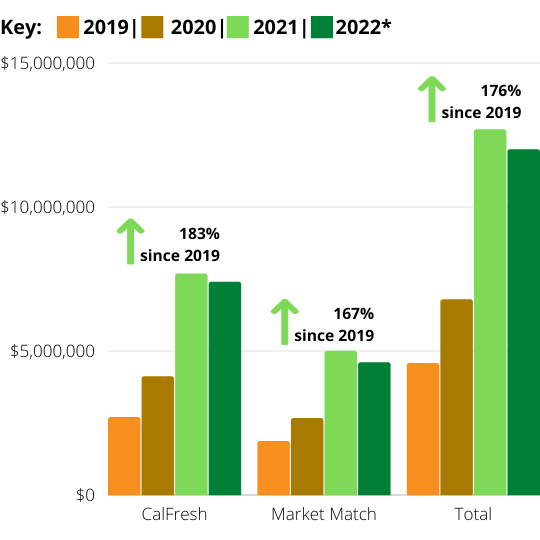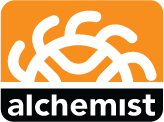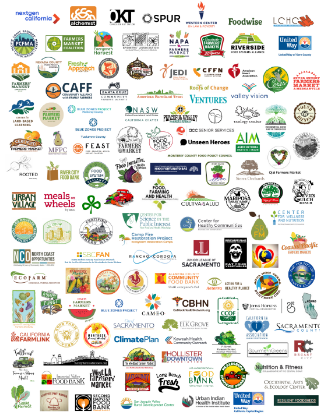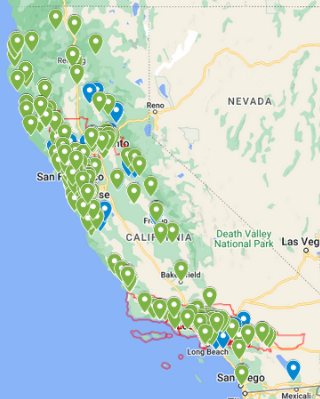LEAF – Local Equitable Access to Food (SB907 2022)
Status
SB 907 (Pan/Caballero/Calderon/McCarty) was signed into California law by Governor Newsom on September 27, 2022. It is now Local Equitable Access to Food: California Food and Ag Code, Division 17, Chapter 14. This important milestone followed unanimous, bipartisan support through both the California Senate and Assembly. The Local Equitable Access to Food (LEAF) program created through SB 907 has not yet been funded and is pursuing funding in the California State Budget for Fiscal Year 2023-24.
We have a strong, diverse statewide coalition supporting the budget request for LEAF and are working to grow it further. Is your organization interested in signing on or in learning more to consider support? Let us know!
Summary
To increase access to fresh, healthy foods for all Californians, and support California’s small and mid-sized farms, NextGen Policy and Alchemist CDC proposed establishing a non-competitive grant program to provide dedicated EBT machines operators and EBT administrative support at every certified and tribal-run farmers’ market in the state. The funding could also be used to scale and improve EBT processes at existing farmers’ markets; establish EBT access at new certified markets in under-served, low-income communities; as well as for education and outreach efforts. LEAF funds will also provide technical assistance to ensure best practices for equitable access are implemented.
Farmers’ markets play an important role in supporting small farmers, who are far more likely than large-scale farmers to be women and/or black, indigenous, and people of color. Increasing EBT access at farmers’ markets will support these farmers while decreasing disparities in nutritional opportunities across our state. Additionally, successful implementation of EBT access at farmers’ markets creates the opportunity for a market to offer nutrition incentives doubling the buying power of CalFresh dollars at the market. This drives increased consumption of fresh produce and leverages state and federal nutrition dollars to support California’s small farms.
Background and Problem
Today, individuals and families that rely on the federal Supplemental Nutrition Assistance Program (SNAP), known as CalFresh in California, are issued an EBT card to access their food benefits electronically. To accept CalFresh at farmers markets, a central Point of Sale (POS) model needs to be established and managed that allows the market to sell EBT tokens or paper vouchers, known as scrip. Customers can then spend their scrip at any eligible food producer/vendor in the market. The producer/vendor later redeems the scrip with the market manager, or in some cases a third party operator, and is reimbursed with cash.
This current system offers many efficiencies but requires dedicated resources that most markets lack. Those markets that offer EBT access typically find that additional operational and administrative support – dedicated employees to operate the machine and the market and handle accounting and reporting – is needed to fully reap the benefits of EBT access. Because these labor costs add up and farmers’ markets operate on such thin margins, this often leaves EBT access at the most fortunate farmers markets dependent upon a varying collection of small grants and funders. Most markets simply do not have the financial resources to provide reliable, high-quality EBT access at all.
Solution
Alchemist CDC estimates that it would cost approximately $1,500 per market per month to ensure effective EBT access (~$9k/year for a seasonal market; ~$18k/year for year-round). In addition to these non-competitive grants, LEAF calls for funds that would be used to contract CBOs with expertise to provide technical assistance in equitable best-practice implementation and new market on-boarding; marketing/education dollars for regional outreach; and funding support for CDFA to adequately staff this program. This catalytic investment would be a triple-win for low-income shoppers, small and mid-sized farms, and California’s rural and urban communities.
Economic Impact and Local Stimulus
A 2016 UC Davis study found “that direct-marketing food producers had a regional output multiplier of 1.86 compared to just 1.42 for producers not involved in direct marketing. Direct-marketing channels include farmers markets, roadside farm stands and community-supported agriculture programs that provide consumers with regular deliveries of farm products.”
Study leader Shermain Hardesty, a Cooperative Extension agricultural economist in the UC Davis Department of Agricultural and Resource Economics noted, “The direct marketers make up a relatively small part of the [region’s] agricultural sector, but this study demonstrates that these food producers generate both economic and qualitative benefits for the region.”
Nutrition incentive programs such as Market Match or Double Up Backs already exist within California and can only be deployed on top of CalFresh/EBT access. When these incentives are factored in, they doubled the original CalFresh dollar spent at a farmers’ market as well as the regional economic multiplier. This means that a $1 in CalFresh spent at a farmers’ market can stimulate $3.72 in local economic activity, creating jobs and building local resilience.

CalFresh and Market Match Trends, 2019-22*
Data in the accompanying chart has been compiled from 160 of California’s 633 certified farmers’ markets (25%). These markets have seen 183% growth in CalFresh distribution and and 167% in Market Match distribution from 2019 to 2021. In 2021, CalFresh and Market Match distribution combined represented a total of $12,685,698 at these markets.
Counties represented in sample:
Alameda, Butte, Contra Costa, Fresno, Humboldt, Los Angeles, Marin, Riverside, Sacramento, San Francisco, San Joaquin, San Mateo, Santa Barbara, Santa Clara, Santa Cruz, Shasta, Solano, Stanislaus, Tehama, Tulare, Ventura, Yolo
*Data for 2022 only includes actual totals. Market data is as recent as July, August, or September.

Do you have questions about SB 907 / Local Equitable Access to Food (LEAF)? Are you interested in getting involved to support. Connect with us and let us know.


